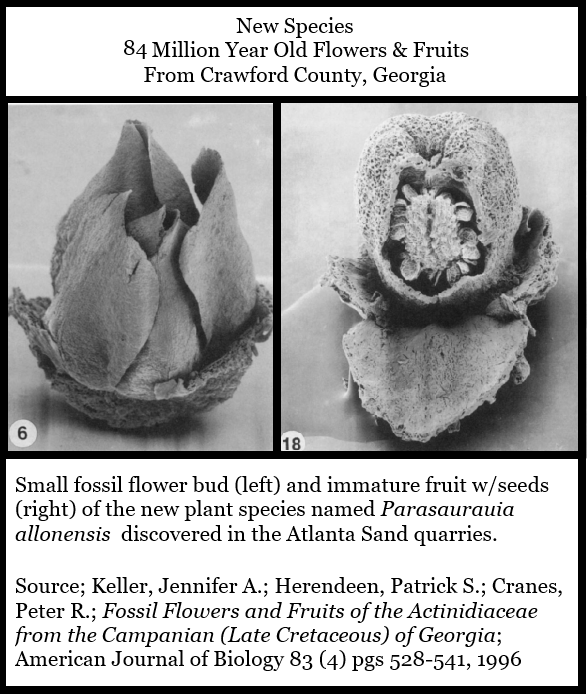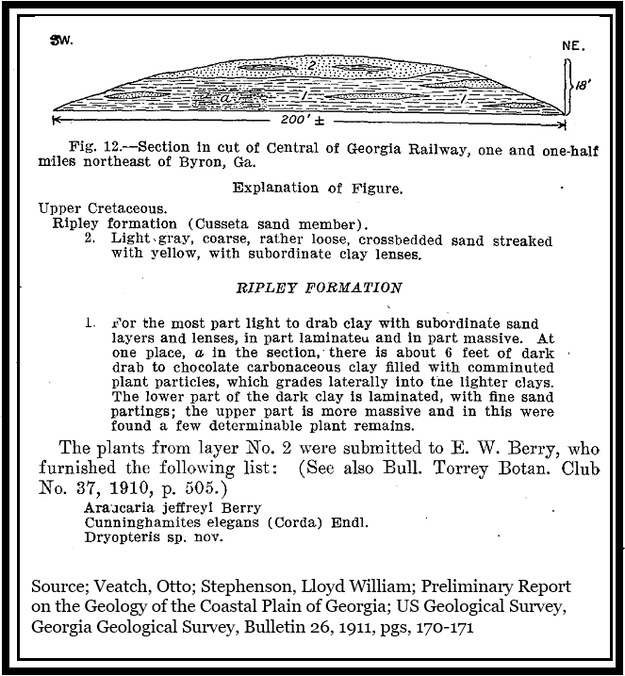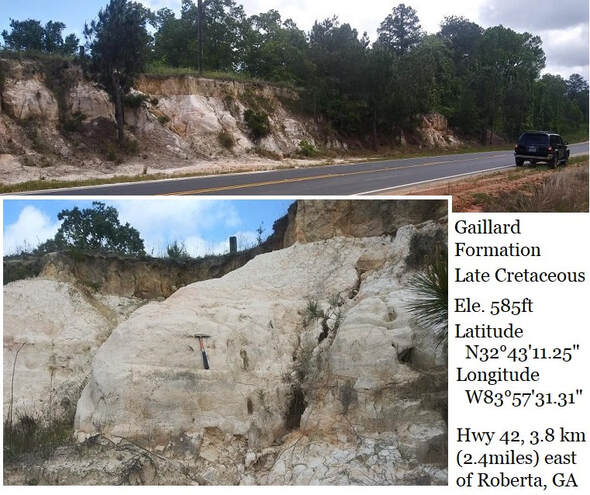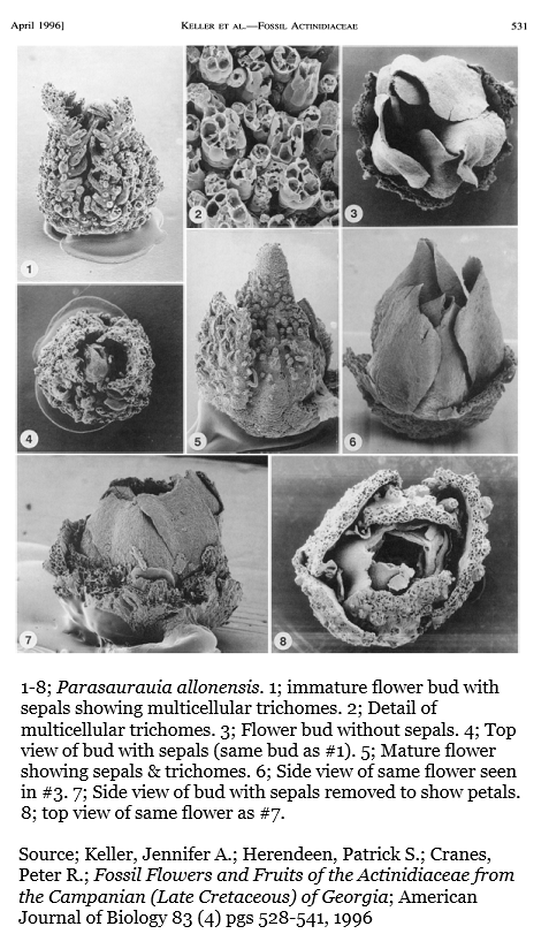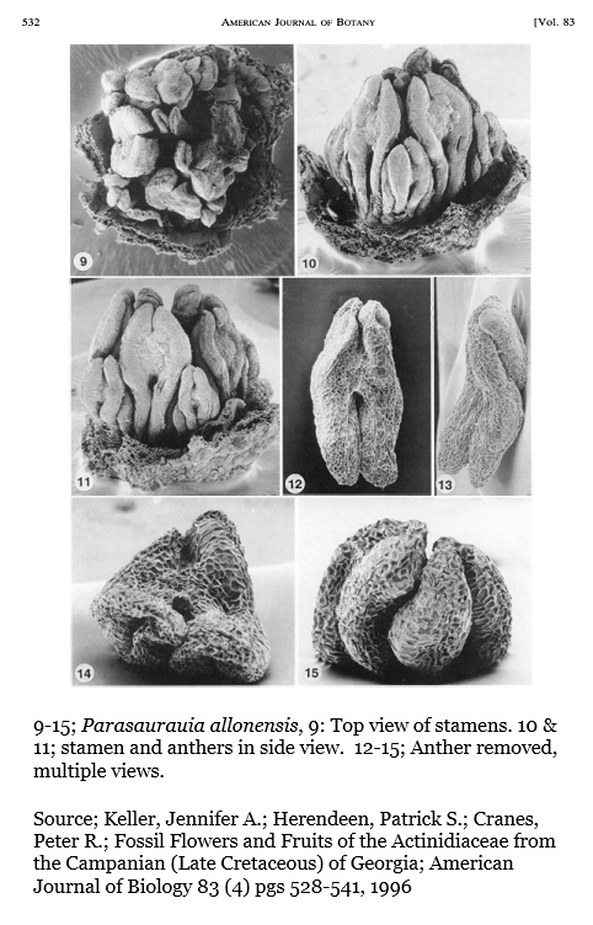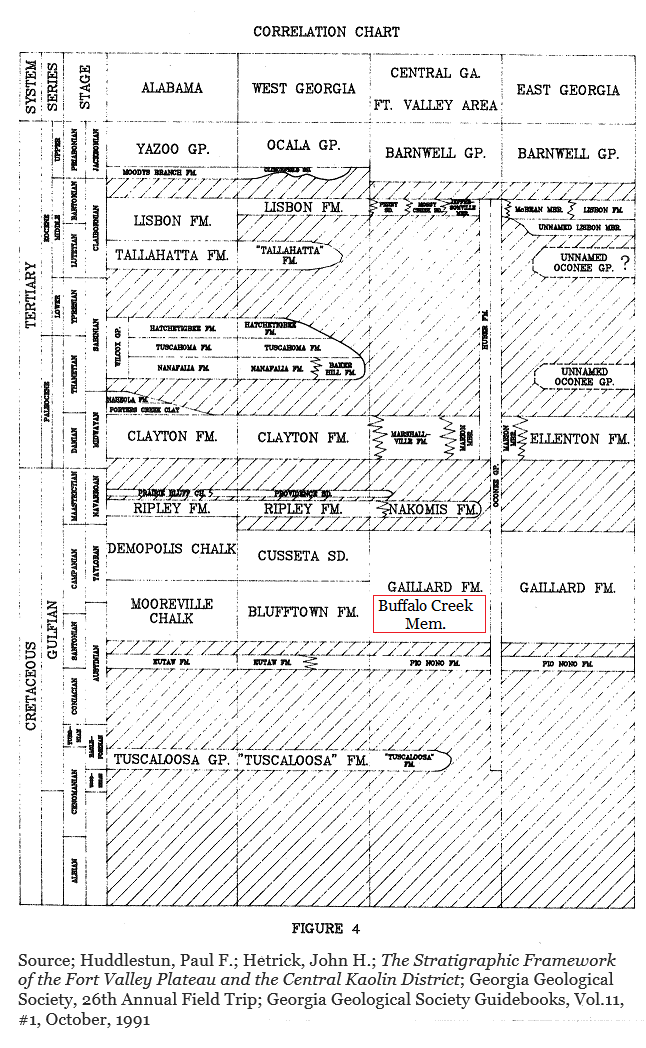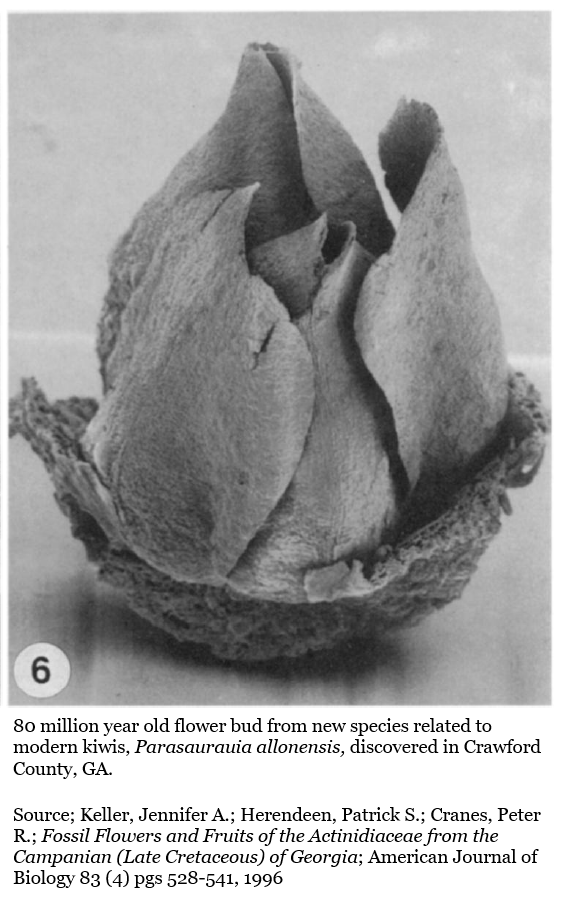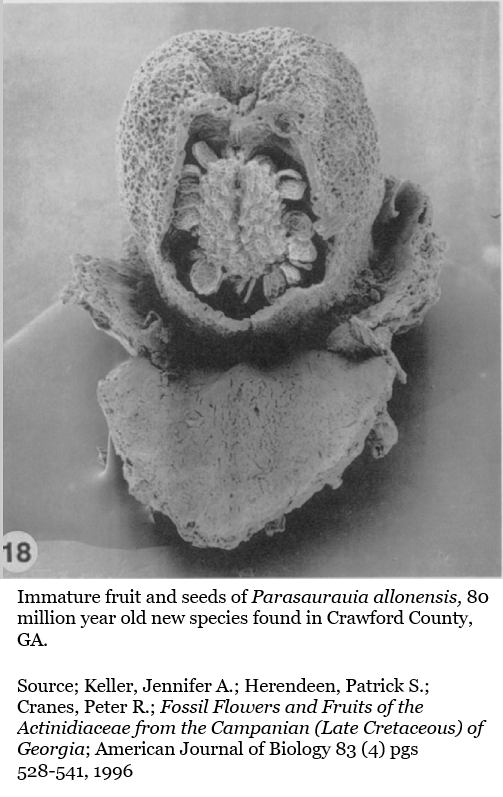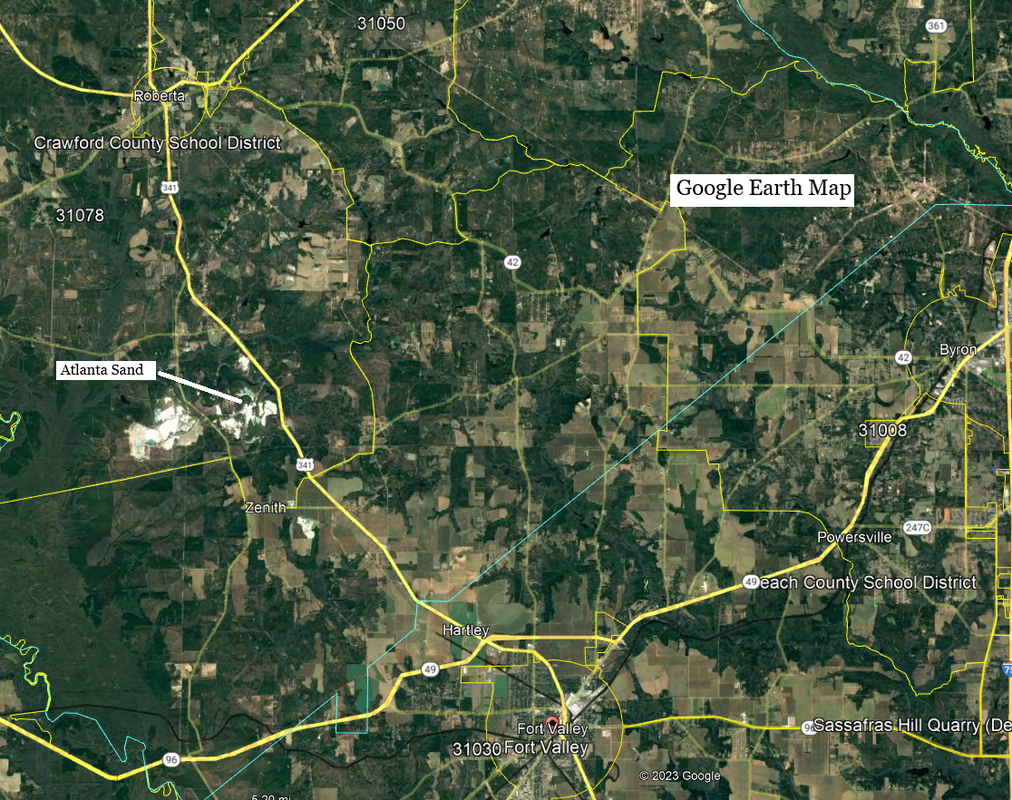7I: New Species Reported
of Cretaceous Fruit & Flower Fossils
From Crawford County
By Thomas Thurman
Filed 23/Aug/2023
In 1996 a new plant species was described from the Atlanta Sand quarries of Crawford County, Georgia. Researchers from the Field Museum in Chicago, Illinois discovered fossils of flowers and fruit from roughly 84 million years old plants which lived while dinosaurs walked Georgia. These fossils were recovered a few miles south of Roberta, and a few miles northwest of Fort Valley.
*Note; originally this material was dated to 80 million years old, but follow-up work moved that date back to 84 million years.*
*Note; originally this material was dated to 80 million years old, but follow-up work moved that date back to 84 million years.*
Paleobotany is the vital study of past plants. Sure, finding a dinosaur fossil is cool, but plant fossils help us reconstruct whole environments. There is a wealth of Cretaceous plant fossils in central and west Georgia. Researchers in 1911 report Cretaceous plants as far west as Byron.
Atlanta Sand operates a series of large quartz sand quarries which are typically devoid of fossils. This is beach-type sand like you'd on gulf shoreline of mostly Tertiary Period in age, or less than 66 million years old.
But in the Allon Quarry, where the fossils were found, the Tertiary sands rest atop Cretaceous kaolin in the Buffalo Creek Member of the Gaillard Formation, which is significantly older and dated to the late Santonian Stage of the Cretaceous Period. The Santonian Stage spans from 83.6 to 86.3 million years old; this would put the early Santonian at roughly 84 million years old.
But in the Allon Quarry, where the fossils were found, the Tertiary sands rest atop Cretaceous kaolin in the Buffalo Creek Member of the Gaillard Formation, which is significantly older and dated to the late Santonian Stage of the Cretaceous Period. The Santonian Stage spans from 83.6 to 86.3 million years old; this would put the early Santonian at roughly 84 million years old.
The research team discovered small, well-preserved flowers and seed-bearing fruit in beds of kaolin. They recovered 4 flowers and 2 fruits representing a previously unknown species which they named Parasaurauia allonensis. It’s related to modern kiwi fruits. The species name “allonensis” refers to Atlanta Sand’s Allon Quarry.
Jennifer A. Keller, Patrick S, Herendeen & Peter R. Crane are scientists with The Field Museum in Chicago, Illinois, studying central Georgia Fossils. Keller led the effort on this paper.
They published their paper Fossil Flowers and Fruits from the Campanian (Late Cretaceous) of Georgia in the American Journal of Biology. (Downloadable below) More plant material was recovered and we’ll explore those papers too.
They published their paper Fossil Flowers and Fruits from the Campanian (Late Cretaceous) of Georgia in the American Journal of Biology. (Downloadable below) More plant material was recovered and we’ll explore those papers too.
The fossils were found using bulk sieving techniques. They’re very small, with the flowers only 1.2mm long. Bear in mind that 1-inch equals 25.4mm. The recovered fruit is assumed to be of similar size, twenty of either would comfortably fit in an inch. They’re considered mesofossils, visible with the naked eye but requiring magnification for detailed observation. These fruits and flowers are preserved as charcoalified or lignitized material. Also preserved are seeds, dispersed stamens, conifer shoots, wood, and coprolites containing plant material.
Yep, coprolites (fossilized poop) are mentioned as occurring, but the word is only used once in this paper and no further details are offered.
The authors refer to the field reports of Paul Huddlestun & John Hetrick, superb work from 1991 describing the area’s sediments. I’m proud to call Paul Huddlestun a friend. Their 1991 work describes the Buffalo Creek Kaolin as the “uppermost fining upward sequence of the Gaillard Formation… sequences consist of thin beds or lenses of relatively pure, soft kaolin; finely sandy, micaceous kaolin, kaolinitic fine grained sand.”
Angiosperms
Parasaurauia allonensis is, of course, an angiosperm. Angiosperms are the large clade of flowering/fruiting plants which make up the vast majority of the plants we depend on.
Fossilized spores suggest that land plants have existed for at least 475 million years. Flowering plants, the angiosperms, appeared suddenly and in great diversity in the early Cretaceous at least 130 million years ago. Clearly, they emerged earlier but there isn’t scientific consensus as to when but there is debatable evidence suggesting angiosperms emerged about 365 million years ago.
Today, there are between 250,000 and 400,000 species of angiosperms, from our trout lilies to our vast live oaks, Georgians are surrounded by angiosperms and depend on them.
Parasaurauia allonensis is, of course, an angiosperm. Angiosperms are the large clade of flowering/fruiting plants which make up the vast majority of the plants we depend on.
Fossilized spores suggest that land plants have existed for at least 475 million years. Flowering plants, the angiosperms, appeared suddenly and in great diversity in the early Cretaceous at least 130 million years ago. Clearly, they emerged earlier but there isn’t scientific consensus as to when but there is debatable evidence suggesting angiosperms emerged about 365 million years ago.
Today, there are between 250,000 and 400,000 species of angiosperms, from our trout lilies to our vast live oaks, Georgians are surrounded by angiosperms and depend on them.
Collecting, Processing,
Identifying, & Preserving Specimens
The fossil bearing material was collected from a clay lens in the Buffalo Creek Kaolin exposed on a face of the quarry wall.
The clay was dried, then dissolved in water and sieved washed through 500 micron and 125 micron mesh screens. (Such sieves are readily available.) A detergent dissolved in water was used to disperse the remaining clay and any organic residue was cleaned with a 10% acid solution. Acid washes and water rinses were repeated daily for several days. The material was then air dried and sorted using a binocular stereo microscope. All steps an amateur could duplicate.
Identifying, & Preserving Specimens
The fossil bearing material was collected from a clay lens in the Buffalo Creek Kaolin exposed on a face of the quarry wall.
The clay was dried, then dissolved in water and sieved washed through 500 micron and 125 micron mesh screens. (Such sieves are readily available.) A detergent dissolved in water was used to disperse the remaining clay and any organic residue was cleaned with a 10% acid solution. Acid washes and water rinses were repeated daily for several days. The material was then air dried and sorted using a binocular stereo microscope. All steps an amateur could duplicate.
From there professional techniques were employed. Specimens of flowers and fruits were mounted, coated with gold, and examined beneath a scanning electron microscope. After being photographed, selected specimens were dissected, recoated with gold and rephotographed. The fossils were then compared to modern specimens.
Historical Research of the Stratigraphy
As part of the Oconee Group, deposits of the Gaillard Formation are fluvial in origin (river-borne, deposited by flowing water). The Allon Quarry at Atlanta Sand is about 4 miles east of the modern Flint River and twelve miles southwest of the modern Ocmulgee River. Of course, when the Gaillard Formation was laid down sea levels were very different, and this part of central Georgia was coastal. There is also evidence that Paleo-Flint River followed a different channel.
As part of the Oconee Group, deposits of the Gaillard Formation are fluvial in origin (river-borne, deposited by flowing water). The Allon Quarry at Atlanta Sand is about 4 miles east of the modern Flint River and twelve miles southwest of the modern Ocmulgee River. Of course, when the Gaillard Formation was laid down sea levels were very different, and this part of central Georgia was coastal. There is also evidence that Paleo-Flint River followed a different channel.
As has been mentioned, in 1991 Paul Huddlestun and John Hetrick authored a survey and field trip into the Fort Valley Plateau and central Georgia kaolin district, where these fossils were found. (Downloadable below) Generally, the kaolin-rich Gaillard is prominently bedded, cross-bedded and contains cut & fill structures. Braided stream systems and abandoned river channels were suspected Huddlestun and Hetrick. The Gaillard Formation overlies the Pio Nono Formation in a disconformity, but in one east Georgia location it was observed to rest directly on Piedmont rocks.
Dating the Gaillard proved difficult for Huddlestun and Hetrick in the late 1980s and earliest 1990s. They observed it overlying the Pio Nono Formation and grading into the Eutaw Formation. It is overlain, as a disconformity, by the Nakomis and Ripley Formations. This suggested that the Gaillard is “broadly correlative” with the Mooreville and Demopolis Chalks of the Selma Group in Alabama, The Blufftown Formation and/or Cusseta Sand of the Chattahoochee River Valley. This led Huddlestun and Hetrick to conclude that the Gaillard was upper Santonian Stage to Campanian Stage in age. That’s roughly 80 to 86 million years old, the Campanian/Santonian horizon is 83.6 million years ago.
Dating the Gaillard proved difficult for Huddlestun and Hetrick in the late 1980s and earliest 1990s. They observed it overlying the Pio Nono Formation and grading into the Eutaw Formation. It is overlain, as a disconformity, by the Nakomis and Ripley Formations. This suggested that the Gaillard is “broadly correlative” with the Mooreville and Demopolis Chalks of the Selma Group in Alabama, The Blufftown Formation and/or Cusseta Sand of the Chattahoochee River Valley. This led Huddlestun and Hetrick to conclude that the Gaillard was upper Santonian Stage to Campanian Stage in age. That’s roughly 80 to 86 million years old, the Campanian/Santonian horizon is 83.6 million years ago.
Huddlestun and Hetrick submitted pollen samples from the Gaillard to Ray Christofer of the USGS and he identified more than two dozen species whose known emergence and extinction ranges could assist in dating the formation through biologic-stratigraphy. Christofer’s conclusions supported Huddlestun & Hetrick’s dating of upper Santonian to lowermost Campanian Stages.
Buffalo Creek Kaolin Member
The kaolin of the Buffalo Creek member is commercial grade. As early as 1989 Sam Pickering and Vernon Hurst reported the Buffalo Creek Kaolin contained plant fossils; “There are some occurrences of carbonaceous and lignitic clay…” Carbonaceous generally means biologically related material. Lignitic, or lignite, is brown coal. Coal is plant fossils. Pickering and Hurst also coined the name Buffalo Creek Kaolin.
As a note, plant fossils as lignite are common in many of the Cretaceous formations, samples up to the size of logs are reported in the literature.
The kaolin of the Buffalo Creek member is commercial grade. As early as 1989 Sam Pickering and Vernon Hurst reported the Buffalo Creek Kaolin contained plant fossils; “There are some occurrences of carbonaceous and lignitic clay…” Carbonaceous generally means biologically related material. Lignitic, or lignite, is brown coal. Coal is plant fossils. Pickering and Hurst also coined the name Buffalo Creek Kaolin.
As a note, plant fossils as lignite are common in many of the Cretaceous formations, samples up to the size of logs are reported in the literature.
Because the Buffalo Creek Kaolin occurs at the top of the Gaillard Formation Huddlestun and Hetrick correlated it more closely to the Cussetta Sand, which would place it in the Campanian Stage, as Keller’s 1996 research team concluded. This would place the Buffalo Creek Kaolin, and the flowers and fruits it contains, at roughly 84 million years old.
Huddlestun and Hetrick place the type locality for the Buffalo Creek Kaolin member on the east bank of Buffalo Creek, on Highway 24 (Fall Line Freeway) about 8.5 air miles west of Sandersville and 4 air miles south of Deep Step. This is only about a mile east of WF Jackson Construction on the Fall Line Freeway. This locality was assigned before construction projects widened Highway 24.
Huddlestun and Hetrick place the type locality for the Buffalo Creek Kaolin member on the east bank of Buffalo Creek, on Highway 24 (Fall Line Freeway) about 8.5 air miles west of Sandersville and 4 air miles south of Deep Step. This is only about a mile east of WF Jackson Construction on the Fall Line Freeway. This locality was assigned before construction projects widened Highway 24.
Crawford County, Eighty-Four Million Years Ago
Today we know Crawford County as rolling hills and ample sand beds. Eighty-four million years ago, while dinosaurs walked Georgia, it was coastal property the Paleo-Flint River was much nearer and the hilltops might have been islands.
A wild plant was flowering and developing small young fruit. Somehow it was disturbed, maybe a branch broke off, and both flowers and fruit fell into the river. They were likely carried a bit downstream, maybe into the river delta, but soon they sank to the riverbed. The Paleo-Flint River was rich in the clay which would eventually become kaolin both flowers and fruits were buried quickly enough that they were badly damaged.
The presence of fruit suggests something was feeding on it, perhaps only insects, I wonder how large the fruit grew.
There four flowers and two fruits sat for 84 million years until paleobotanist from the Field Museum of Chicago, Illinois came to Crawford County to do some science.
There’s much science yet to do in Georgia’s fossil record.
Today we know Crawford County as rolling hills and ample sand beds. Eighty-four million years ago, while dinosaurs walked Georgia, it was coastal property the Paleo-Flint River was much nearer and the hilltops might have been islands.
A wild plant was flowering and developing small young fruit. Somehow it was disturbed, maybe a branch broke off, and both flowers and fruit fell into the river. They were likely carried a bit downstream, maybe into the river delta, but soon they sank to the riverbed. The Paleo-Flint River was rich in the clay which would eventually become kaolin both flowers and fruits were buried quickly enough that they were badly damaged.
The presence of fruit suggests something was feeding on it, perhaps only insects, I wonder how large the fruit grew.
There four flowers and two fruits sat for 84 million years until paleobotanist from the Field Museum of Chicago, Illinois came to Crawford County to do some science.
There’s much science yet to do in Georgia’s fossil record.
Download the papers referenced
| keller_fossil_flowers_and_fruits_of_the_actinid__1_.pdf | |
| File Size: | 4291 kb |
| File Type: | |
| ft._valley_plat_strat_ggs1991.pdf | |
| File Size: | 28797 kb |
| File Type: | |
| ga-7_fort_valley_atlas.pdf | |
| File Size: | 5606 kb |
| File Type: | |
References
- Keller, Jennifer A.; Herendeen, Patrick S.; Cranes, Peter R.; Fossil Flowers and Fruits of the Actinidiaceae from the Campanian (Late Cretaceous) of Georgia; American Journal of Biology 83 (4) pgs 528-541, 1996
- Huddlestun, Paul F.; Hetrick, John H.; The Stratigraphic Framework of the Fort Valley Plateau and the Central Kaolin District; Georgia Geological Society, 26th Annual Field Trip; Georgia Geological Society Guidebooks, Vol.11, #1, October, 1991
- Hetrick; John H.; Geologic Atlas of the Fort Valley Area, Geologic Atlas 7, Georgia Geologic Survey, 1990
- Veatch, Otto; Stephenson, Lloyd William; Preliminary Report on the Geology of the Coastal Plain of Georgia; US Geological Survey, Georgia Geological Survey, Bulletin 26, 1911
